|
Monday, July 19, 2010
Progress Notes
Helen McCommons Cantwell (photo 01) was the first person to establish a beauty shop in Miller County, which she located in Eldon.
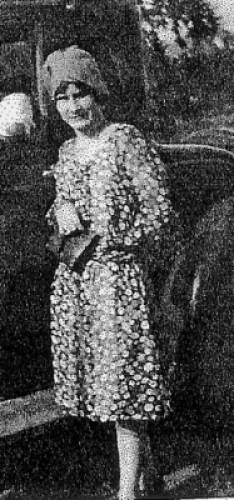
01 Helen McCommons Cantwell Helen was the daughter of John and Margaret Graham McCommons, who owned a large farm near Ulman. The McCommons family was well known in the county; Ida McCommons, John’s sister, married George Hauenstein who built the large Hauenstein’s store in Tuscumbia. You can read more about the McCommons family on our website.
Soon after she opened her beauty shop (as they were called then) Helen married Burleigh Cantwell. Their story was told in a special edition of a publication of the Mercantile Bank in 1973:
Cantwells Retiring This Month After More Than 40 Years in Business (photo 02)
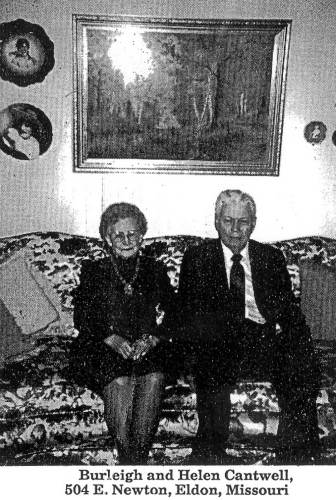
02 Helen and Burleigh Cantwell More than 40 years in business in Eldon are drawing to a close for Mr. and Mrs. Burleigh Cantwell. The Cantwells have sold Cantwells’ Hairdressers at 7 S. Maple Street to Mrs. Harold (Carol) Hawkins, and will retire to their hobbies this month. Friday, April 18, will be their final day in their shop.
Mrs. Cantwell brought professional hairdressing and cosmetology to Eldon. She was Miss Helen McCommons, formerly of Tuscumbia, when she opened Miller County’s first beauty shop at 107 South Maple Street in Eldon in 1926. She had received her training in St. Louis at the Marinello School. The shop was not only the first in the county, but one of the few in mid Missouri. Jefferson City had two beauty shops and Columbia had two, Mrs. Cantwell recalled. The Cantwells were married in 1928, and Mr.Cantwell, who attended Moler Beauty School in St. Louis, joined his wife in business.
They have been in their present business location in Eldon since 1933. Previous locations included a shop on First Street, just east of Maple Street, and then into a new building on Maple Street, now occupied by Midway Barber Shop.
Mr. and Mrs. Cantwell have shared duties in the shop for more than 40 years with the exception of an interruption during World War II when Mr. Cantwell was away on Navy duty.
They have been active in the National Hairdressers and Cosmetologists Association throughout their years in business.
The Cantwells have seen a complete change in hairdressing techniques and beauty work during the decades. Marcelling and spiral waving were the hairdressing methods of those first years; “And facials were very popular, too,” Mrs. Cantwell recalled.
Cold waving came in during World War II, and brought with it a complete change. Mrs. Cantwell could recall only four men still active in the business and professional community of Eldon who were here when she opened that first shop…Gentry Smith, Harry Day, Harry Harvey and Ralph Reed.
The Cantwells in recent years built a new home on E. Newton Avenue and retirement will give them more leisure to devote to it. “We really haven’t thought what we’re going to do,” he said.
Both are active in church work.
They also share enthusiasm for square dancing, and he has enjoyed the hobbies of lawn care and fishing and other outdoor sports.
“Our years in business here have been most pleasant,” they commented.
Mrs. Hawkins, who now operates La Vera Salon, plans to merge the two shops and begin operations in the building purchased from the Cantwells at 7 South Maple Street on Monday, April 21. It will be known as Carol’s Cantwell Salon with five operators, including Mrs. Hawkins.
Mrs. Hawkins, a hairdresser for 11 years, has been in business in Eldon for four years. She took her training in Quincy, Illinois and worked in Columbia before buying a shop in Eldon.
As noted above, Burleigh served in WWII in the Navy. During that time he received a purple heart for wounds suffered in action. The family donated the Purple Heart to our museum where we have it prominently displayed in our museum (photos 03 and 04).
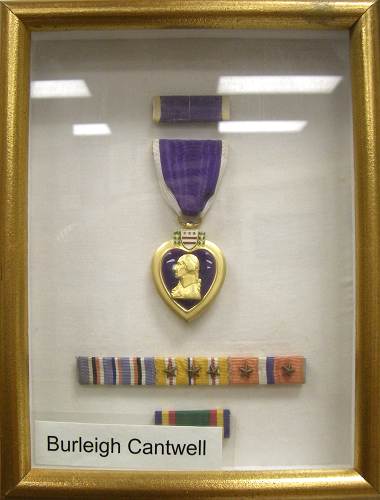
03 Purple Heart - Burleigh Cantwell
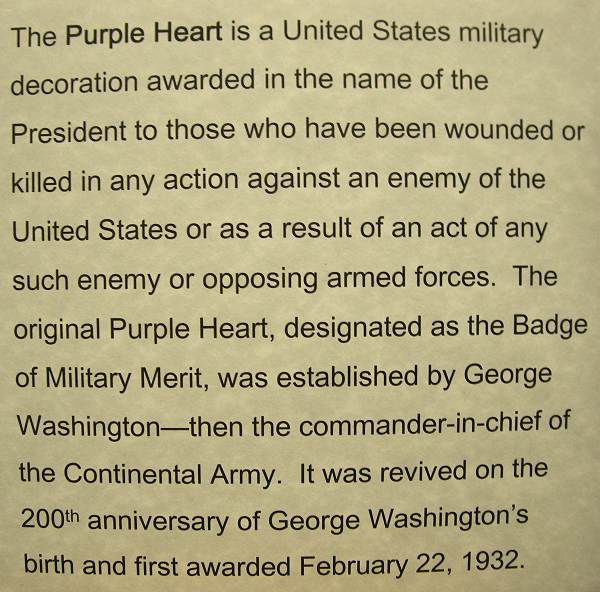
04 Purple Heart Significance Marilyn Barron Bosso, a niece of Helen, had the following comments about her aunt to share:
In addition to opening the first beauty shop in Miller County, Aunt Helen also was known as the first beautician to give a marcel and first to use the latest of permanent wave procedures. Uncle Burleigh and she lived in the back of the beauty shop as long as they were in the profession, more than forty years. Only after they retired did they build their new house on Newton Street.
Note: The Marcel Wave (sometimes spelt Marcelle) is a stylish wave given to the hair by means of heated curling irons. Named for Francois Marcel, 19th century French hairdresser who invented the process in 1872. It revolutionized the art of hairdressing all over the world and remained in vogue for over fifty years, making a fortune for Mr. Marcel. Originally known as the "Undulation Marcel", the name evolved to the "Marcel Wave." Read more about it at this website.
A highlight of my growing up was riding the Tuscumbia to Eldon mail truck to visit them on Saturday afternoons. We would go to the movie on Saturday and to church on Sunday morning. Then they would take me home. During the time of the second World War, I would spend week ends with Aunt Helen. The treat was once again a movie, but also, in addition, a pineapple sundae at Eldon Drug Store each time I visited. But for the thrill of your life, a trip with Aunt Helen in her ’39 Nash was tops. I couldn’t wait to learn how to drive (photo 05)!
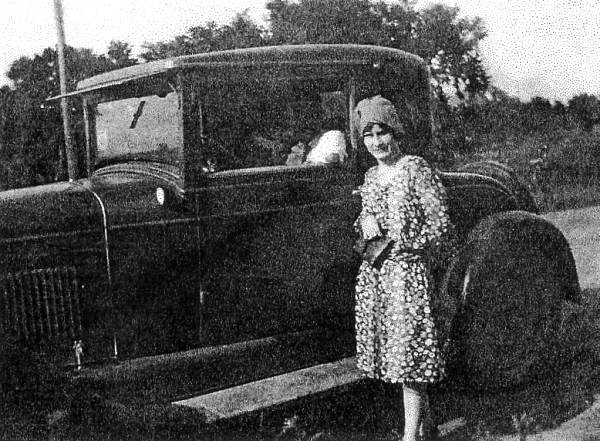
05 Helen McCommons Cantwell
My mother had her own beauty shop in Tuscumbia when I was a child. She actually started fixing ladies’ hair in Tuscumbia when she was only about 12 years old. She is 89 year old now. She wrote a very extensive article about her experiences as a hairdresser in an article of a previous Progress Notes.
You will need to scroll down the page more than half way to find her narrative.
I came across an old article in the Autogram which featured the Miller County Nursing Home which is located about three miles south of Tuscumbia on Highway 17. Presently, the facility is known as the Miller County Care and Rehabilitation Center.
When I was a boy it was known as the Miller County Home for the Aged. Before that it was known as the “Poor Farm.” For many years the farm on which it was located provided most of the food for the residents (who then were called “inmates.”) I have been very impressed with the care given to residents at our current facility which a few years ago replaced the older one. The new one is modern in every way including the care given to the residents under the leadership of director Joyce Malmberg.
The article below certainly shows how times have changed not only in the language used to refer to the residents but also how the facility had to be run pretty much on a self sufficient basis:
The Comforts They Deserve
Miller County’s Aged Enjoy Real Comforts Of Home On Farm In Their Declining Years
Tuscumbia Autogram, February 28, 1946 (photo 06)
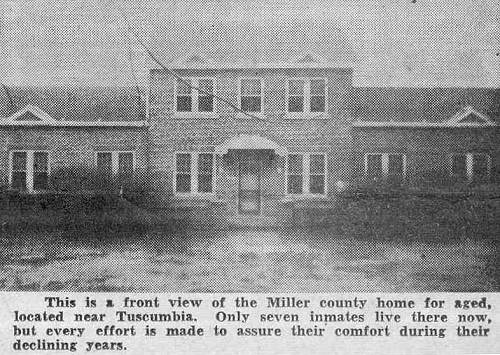
06 Miller County Home for the Aged
Click image for larger viewSomething new in the line of entertainment and comfort is currently being offered members of the Miller County home for the aged. Members of the Aurora Springs Baptist church choir and Brotherhood only recently presented another of their recitals at the home. This is always held on Sunday afternoon and is climaxed with a sermonette by the pastor of the church, Reverend Frank Smith. Programs such as this are usually arranged by the superintendent of the home, Milton Cooper, and his wife, and never fails to attract a large number of visitors from this and surrounding communities. It also affords a welcome break in the long winter days for the home inmates and is greatly enjoyed by them.
Miller County takes pride in its county farm home, and it is always open to visitors who agree as to its comforts, convenience and beauty which makes it just like home. Located on Highway 17 south of here, the farm consists of 190 acres of rich bottom farm land, cut it two by a swiftly flowing stream known as Dog Creek. Farther up the line, “Cattail,” another branch, winds its way among the hills of timber which provide the winter’s fuel for the huge furnace.
The home has 16 rooms, with full basement and three baths. The men’s quarters are located in the right wing on the south, and the women’s on the north wing.
Superintendent Cooper and his wife, have had two flings at the job of supervising the farm. The last time has been for a little over three years. Prior to this, the Cooper’s worked at the farm for 12 years, but Mrs. Cooper fell and suffered an injury which has compelled her to use crutches for several years. She is still unable to walk without assistance but says she manages very well with the help of her assistant, Miss Arzena Stark, who has been with the Coopers for over seven years.
The home was built in the spring of 1931 and for 15 years of this time has employed the same caretaker. Speaking of this, Mrs. Cooper recalled the days when she managed the home with no help at all, and there were 27 inmates of the home at that time. There were times when Cooper himself had a few moments to assist with the house hold duties, but aside from this she said she cooked, sewed, cleaned and canned for them all by herself.
At present there are only seven persons at the home, three men and four women, so the work has changed somewhat from the early days, Mrs. Cooper recalled.
Superintendent Cooper stated that he makes a desperate effort to make the farm pay its way. But in these days of high prices there are difficulties to be encountered, as the average farm owner and operator well realizes. The farm has the distinction of having the finest barn in the county, and around the barn lot about 160 leghorn hens were scratching and digging happily. This lot joins their quarters which includes several modern poultry houses.
Four milk cows furnish milk, cream and butter for the home, although Cooper said the usual number kept for this purposes about ten. Twelve head of beef cattle range the farm pastures and here again Cooper explained they usually own about 20 head or more. Current high prices of livestock, along with the decrease of persons at the home, account for the smaller herds.
The farm furnishes its own meat with one beef killed this winter. This too, varies according to the need. Usually eight or ten hogs are butchered. This increases the labor for Mrs. Cooper and her able assistant, who was justified in proudly displaying the appetizing assortment of canned fruits, vegetables and meats stored in the roomy cellar, all of which were the farm’s own product.
They produce hundreds of fryers each summer which are also later put in the jars for winter use, and, Arzena pointed out, the garden had already been manured and plowed awaiting spring planting, which will require a lot of hard manual labor. She will do her part here, as she assists with the milking and feeding, as well as the housework and can take a turn or two at the tractor when needed in the hay and corn harvesting.
The appliances, of course, are all electric, except for the old fashioned kitchen range, and Mrs. Cooper, along with members of the home, insists that fried chicken and pumpkin pie just naturally have a better flavor when cooked on the wood range than on the modern stoves. The kitchen is roomy and has a homey appearance, but what made the greatest impression was the huge, old fashioned churn of rich, jersey cream waiting to be “dashed.”
There is a special sewing room upstairs and Arzena says she does sewing for the inmates, as well as herself and Mrs. Cooper. The windows were filled with potted house plants, all in bloom, and in the front reception room blossomed a large hibiscus plant, with branches reaching almost to the ceiling.
Nearby, an old time clock chimed the hours away, while a merry throated canary hopped along the window sill. In a way, maybe it gives the inmates a bit of security to know that the home and farm where they live is self sufficient to provide them their board and room and that the staff which works there is skilled and dedicated to their care and comfort.
For further interesting information about the facilities the county had in the past for the aged and the poor refer back to the Progress Notes May 4, 2009 which discusses the old “County Poor Farm.”
A couple of weeks ago we hosted visitors who were descendents of the Bear, Tyler, and Shelton families of Miller County (photo 07).
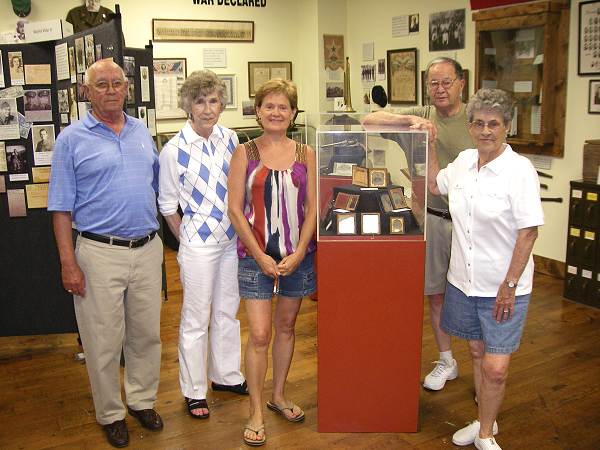
07 David and Sandra Bear Shelton, Ginger Tyler Woodman, Bud and Bonnie Bear Tyler The group pictured in this photo are left to right David and Sandra Shelton, Ginger Woodman, Bud and Bonnie Tyler. Sandra and Ginger are great great granddaughters of George Bear, and Bonnie is a great grandaughter of George Bear. The group is standing at the George Bear display in our museum, which features George’s family, especially his six sons who fought for the Union in the Civil War. David and Sandra originally were from Eldon but live now in Rolla. Sandra is the daughter of Arthur Bear, now deceased, who was a great grandson of George Bear. Bonnie, Sandra’s aunt, was raised in Tuscumbia and is the daughter of Madison Bear, grandson of George Bear. Bud, Bonnie, and their daughter Ginger live in Alton, Illinois. Bud is a descendent of the local Tyler family, which lived in Miller and Pulaski counties. In the 1950’s Bud and Bonnie taught school at Eugene as well as Iberia. Arthur Bear, father of Sandra, for many years owned the Sanitary Market in Eldon. David is the son of Dr. Olney Shelton, who practiced in Eldon for many years as did his father Edward Shelton before him.
You can read more about the Bear family on our website.
The Tyler family history can be found here.
And you can read about the Shelton family here.
From time to time I am copying for this website biographies of important early Miller County residents who played a significant role in the history of the county. My criterion for selection of these individuals is based on those people that the Goodspeed Publishing Company chose for their book, “The History of Miller County” published in 1889. The person I have chosen for this week is Theodore B. Robinson (photo 08).
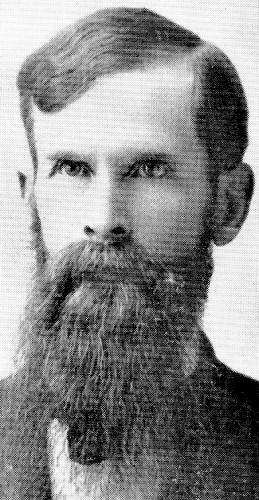
08 Theodore B. Robinson Following the Goodspeed biography I will add the history compiled by Peggy Hake which adds information regarding Mr. Robinson after 1889 subsequent to when the Goodspeed book was published.
Mr. Robinson was an eminent lawyer who served as prosecuting attorney, circuit judge and Republican national convention representative. In addition he was appointed Judge of the Missouri 14th Judicial Circuit in September 1899. He also was a charter member of the Tuscumbia Christian church being very active in its organization and the construction of the church building in 1888.
Theodore B. Robinson
Goodspeed’s History of Miller County
p.807
T. B. Robinson, attorney at law at Tuscumbia, Miller County, was born in St. Francois County, Missouri, April 3, 1837, and is the son of Philip R. and Margaret (Moore) Robinson, the father a native of Kentucky and the mother of East Tennessee. Philip R. Robinson immigrated with his father, John Robinson, to St. Francois County in 1803, when it still belonged to the French, and the State was then a wild territory. They came down the Ohio River in a flat boat, locating near Farmington, and here the grandfather died. Philip R. Robinson was the eldest son born to his parents, his birth occurring in 1797. He was but seven years of age when he came to Missouri, and he remained in St. Francois County until about 1849, when he removed to Miller County, Missouri, and located eight miles south of Tuscumbia, at Little Richwoods, where he entered land. He died in that county in 1879, and the mother died about 1856. They were the parents of eleven children, five now living: Joan, wife of W. Ponder; Elizabeth R., widow of H.C. McFarland, and resides in Illinois; Theodore B.; Rachel, wife of Jesse Salsman, and Sarah E., wife of J.M. Warnell. T.B. Robinson was principally reared in Miller County, and there attended the common schools. In 1861 he enlisted in the Osage Regiment Missouri Home Guards, where he remained a short time and then re enlisted in Company H, Sixth Missouri Cavalry, and served a little over three years. He was first sergeant, was in all the principal engagements from Pea Ridge to Red River, and was mustered out at Baton Rouge, Louisiana, in February, 1865. He then returned home, and in 1866 he was elected county and circuit clerk. He was re elected in 1870 and 1874, served until January 1, 1879, thus holding the office for twelve consecutive years In the meantime he read law, and was admitted to the bar in September, 1878. He was elected prosecuting attorney in 1880, and re elected in November, 1886, holding the office until January, 1889. Mr. Robinson is one of the leading and influential citizens of Miller County, and has made his own mark from a boy up. He was married first on March 26, 1865, to Miss Martha C. Hawkins, by whom he had one child, Olive, wife of Professor Moles, of Aurora Springs. The wife died in June, 1868, and Mr. Robinson was again married, January 2, 1870, to Porthena McCarty, a native of Tennessee, who came to Missouri with her parents when but an infant. Mr. and Mrs. Robinson are members of the Christian Church, and are active church workers. He is a member of the Masonic fraternity, is a member of the I.O.O.F. lodge, and also belongs to the G.A.R. He was a delegate to the national convention from the Eleventh District to Chicago in 1888, in the interests of the Republican Party. Mr. Robinson is interested in farming to some extent, and is the owner of several good farms in the county besides town property.
The following article about Theodore B. Robinson was written by Peggy Hake and can be found on our website.
THEODORE B. ROBINSON (photo 09)
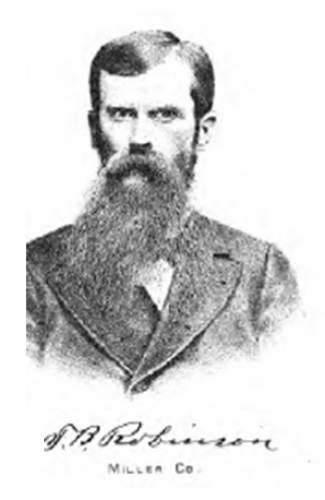
09 Theodore B. Robinson Theodore B. Robinson was born 3 Apr 1837 about three miles west of Farmington, St. Francois County, MO. He was one of eleven children born to Philip R. Robinson (1797-1870) and Margaret M. Moore (1801-1856). His father was born in Kentucky and his mother in East Tennessee.
Their children were:
OSCAR F. ROBINSON 1821-1861 died in Civil War
HARRIETT N. ROBINSTON b. c/1822
AMANDA M. ROBINSON b. c/1824
ELIZABETH R. ROBINSON b. 1826 m. H. C. McFarland
GEORGE W. ROBINSON 1830-1863 m. Elizabeth J. Reed (he also died in the Civil War)
JOANNA H. ROBINSON 1831-1916 m. Wencelaus Ponder
MARY M. ROBINSON b. 1834 m. Alexander Carnes
THEODORE B. ROBINSON 1837-1900 m.
(1) Martha Hawkins
(2) Parthenia Burks-McCarty
GERALDINE F. ROBINSON 1840-1869 m. Henry Bear
RACHEL B. ROBINSON b. 1843 m. Jesse D. Salsman
SARAH E. ROBINSON 1845-1907 m. Mastin J. Wornell
The Robinson family came to Miller County from southeast Missouri in 1849 and located eight miles south of Tuscumbia in the Little Richwoods. Theodore was a young boy when his family came to Miller County and he attended the common schools in his district. In 1861, at the age of 24 years, he enlisted in McClurg's Regiment of the Missouri Home Guards and later enlisted into Co. H of the 6th Missouri Cavalry where he served three more years during the war. He had one brother, George, who also served in the Union Army. Their oldest brother, Oscar, served with the Confederate troops and was killed near Springfield in the battle of Wilson's Creek. It is thought that brother fought brother in that battle and did not know the other was there!
Before his discharge in February 1865, Theodore was involved in battles in Pea Ridge, Arkansas; Vicksburg, Champion Hill, and Ft. Gibson, Mississippi; and then took part in the Red River expedition. He returned back to his Miller County home in 1865 and within a month had married his first wife, Martha C. Hawkins, daughter of William and Catherine (McCubbin) Hawkins of the Brumley area. She died in 1868 and he then married Parthenia Burks-McCarty in January 1870. Parthenia was the widow of P. Gordon McCarty and they had one daughter, Mary/Mollie McCarty, born c/1852.
Theodore Robinson was the father of one child, a daughter Mary Olive Robinson, who was only a baby when her mother died in 1868. He also reared his stepdaughter, Mary/Mollie McCarty. Theodore's daughter, Mary Olive, married Professor Herbert Lee Moles in 1884 and his stepdaughter, Mary/Mollie McCarty, married Joseph L. Cummings in 1888.
The children of Mary Olive (Robinson) and Herbert Moles were:
OPAL MYRTLE MOLES 1886-1889
ETHEL SUSAN MOLES b. Oct 1888
RUBY MOLES b. Mar 1891
ROBERT MOLES b. Aug 1892
THOMAS H. MOLES b. May 1894
JOEL LEO MOLES 1896-1900
MARY O. MOLES b. Jun 1898
HERBERT MOLES 1899-1900
Even though Theodore was the father of only one child, he was the grandfather of many grandchildren which he enjoyed over the years.
In 1866, Theodore Robinson was elected county clerk and circuit clerk of Miller County and held those offices for 12 years. After leaving public office, he began to read law and was admitted to the bar in September 1876. By 1880, he entered politics once again and was elected prosecuting attorney of Miller County. In 1888, he was elected as a Republican state delegate from the 11th District to the National Republican Convention in Chicago. The Convention nominated Benjamin Harrison as Republican candidate for President and he was elected in the following general election. The Robinsons had been supporters of the Democrat party prior to coming to Miller County but Theodore changed his politics to Republican during the years he ran for and held public office in the county. Later, he changed back to the Democrat party and was appointed to fill the vacancy of Judge of the Missouri 14th Judicial Circuit in September 1899. The circuit included the counties of Miller, Cole, Maries and Moniteau. He held that office almost a year until his death, in August 1900.
Judge Theodore B. Robinson was a member of the Christian Church, the Iberia Masonic Lodge #410, the I.O.O.F. (Independent Order of Odd Fellows), and the G.A.R. (Grand Army of the Republic) and was a prominent attorney in Tuscumbia for many years. He owned several good farms in the county as well as town property in Tuscumbia.
In August 1900, Theodore B. Robinson died at his home in Tuscumbia at the age of 63 years. He was preceded in death by his two wives, Martha (Hawkins) in 1868 and Parthenia (Burks-McCarty) in 1893. Mary Olive (Robinson), only child of Theodore, lived only two months longer than her father. She died in October 1900. Professor Moles, Mary's husband, was left with several small children to rear along. He married his second wife, Olive May Atkinson, in 1902 and she reared Theodore's grandchildren. The Robinson and Moles families are buried in Tuscumbia Cemetery.
Of personal interest to me was the fact that Theodore’s sister, Geraldine Robinson, married my great great uncle, Henry Bear (photo 10).
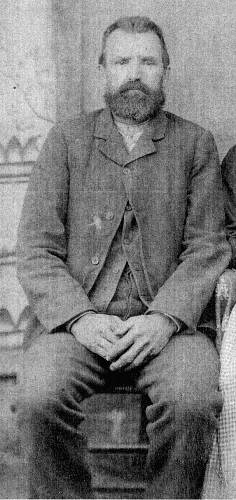
10 Henry Bear She was the second of Henry’s three wives. With Geraldine he had four daughters; both Geraldine and his first wife, Lucinda Spearman died leaving him a widower. His last wife was Virginia Castleman.
About three weeks ago the annual Kallenbach reunion was celebrated at the museum. One of the visitors this year was Jim Blackburn (photo 11).
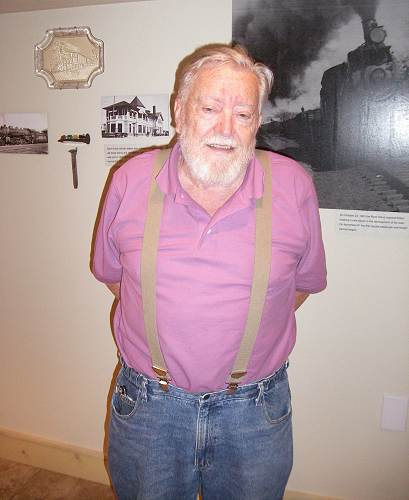
11 Jim Blackburn Jim’s grandfather was John Kallenbach (photo 12).
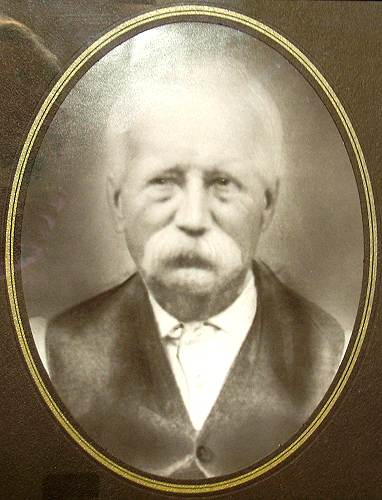
12 John Kallenbach Jim’s name sake in the county was James Green Blackburn who was Jim’s great grandfather. James was a brother to John L. Blackburn, who was on the county court in the early 1900’s (photo 13).

13 John L. Blackburn According to Jim, the first Blackburn who settled in Tuscumbia was James Jeffrey Blackburn. He said the Blackburn family owned a farm on Highway 17 east of Tuscumbia. These plat maps of 1905 shows it was located in the lower left corner of section 2 just a slight distance north and east of Tuscumbia, and indicates that at that time, John L. Blackburn owned the farm (photos 14 and 15).
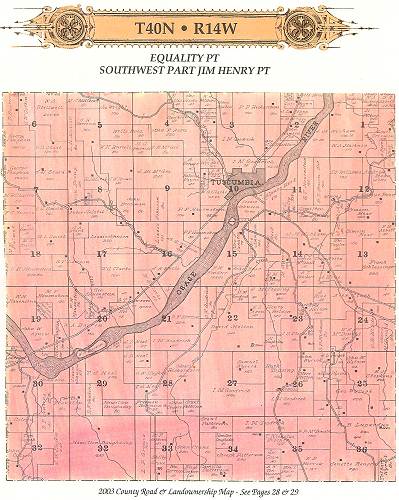
14 T40N - R14W
Click image for larger view
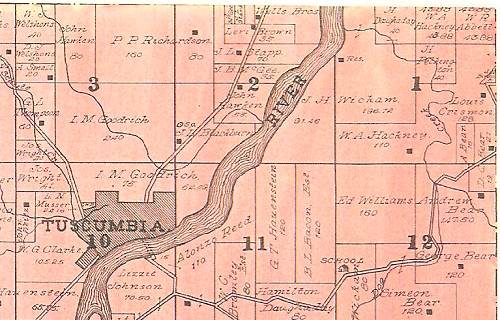
15 T40N - R14W - Section 2
Click image for larger viewJames was born and raised around Etterville. He went to Central Methodist College in Fayette and got his PhD in Social Sciences at the University of North Carolina at Chapel Hill. He has lived in Birmingham for more than thirty years and taught at Birmingham Southern University.
I always enjoy getting to know the people who come to visit our museum; most come because they had ancestors and roots here and I almost always learn something new about our county’s history.
Many visitors to the museum when told that the smaller cabin on our grounds was a slave cabin before the Civil War are surprised to know that before and during the Civil War a significant number of slaves were living here, owned mostly by landowners of origin from the southern states of Virginia and North Carolina (photo 16).
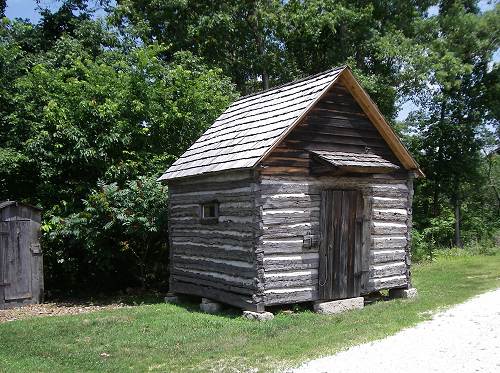
16 Williams Slave Cabin Note: You can read the story of the cabin as told by Sue Steen Cates at this previous Progress Notes page.
Clyde Lee Jenkins (photo 17) in his history of Miller County recorded as many as 234 slaves listed on a county tax inventory (Judge Jenkins History of Miller County 1971 p. 229).
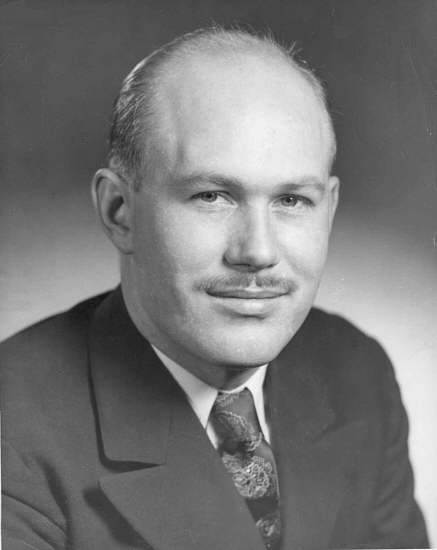
17 Clyde Lee Jenkins Clyde had the opportunity to talk with people who had known slave owners and he also had access to county records at the Courthouse which documented the ownership and location of the slaves. Clyde discovered records indicating instances of cruelty as well as kindness regarding the treatment of the blacks who were slaves here. However, one incident Clyde described made a significant impression upon him:
Judge Jenkins’ History of Miller County
p. 232
“The selling of slaves were events of great importance in a community. The main centers for auction were at Pleasant Mount and Tuscumbia. An eyewitness account, as a very small child, of the selling of a number of slaves at Locust Mound in the 1860’s was given by a citizen of Miller County, who died in the 1950’s, when nearly one hundred years of age.
He remembered an immense crowd of people standing around a flat stump, three or four feet in height, and five or six feet in diameter. This was the auction block, located at the edge of a great grove of locust trees, where the slaves were sold. He remembered an elderly man, a middle aged woman, two teen aged girls, and a girl child of colour, offered at public vendue (obsolete French, from Middle French, from vendre meaning a public sale at auction).
The sale commenced by stripping the slaves of their clothing, and each, in turn, was ordered upon the stump, standing naked before the crowd. As the auctioneer chanted, each slave slowly turned, assuming various positions upon master’s orders, so that all parts of each slave’s body could be viewed by prospective purchasers. One teen aged girl, he remembered, becoming rather happy, commenced dancing a little jig, keeping in step with the chanting rhythm of the auctioneer. The crowed responded by loudly clapping hands.
In modern times such an event would be repugnant beyond description to every citizen, but it must be remembered, all the worst evils of civilization have occurred in Miller County, some events beyond printing even in history books.”
Regarding Clyde’s last statement, he should know I suppose, since no one before Clyde interviewed so many people from the past who were eye witnesses to the events he describes in his book, nor has anyone reviewed so many records and documents at the court house as did Clyde. Today many of these records are deteriorating because of age. Fortunately, the State of Missouri Archives microfilmed most of them several years ago.
You can read more about the history of the slave cabin on our museum grounds as told by Sue Steen Cates, great great granddaughter of John Williams, the slave owner who owned the farm where was located the cabin, on our website.
Miller County historian Gerard Schultz (photo 18) also has written about the history of the enslavement of black people not only in Miller County but the general area of the northern Ozarks in his book, “Early History of the Northern Ozarks,” published in 1937 (photo 19).
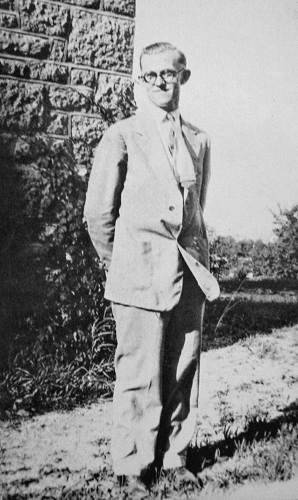
18 Gerard Schultz
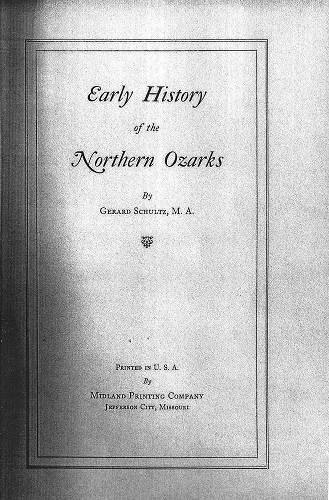
19 Book Cover The following narrative from Gerard’s book, which summarizes some of the data about the slave demographics and history in our county and surrounding areas, is copied here:
Early History of the Northern Ozarks
Published 1937
Negro Slavery
P. 76-82
Gerard Schultz
The mining of lead in modern Washington County caused the introduction of negro slavery into the region of this study as well as into the present limits of Missouri. The first negro slaves were brought to this region for this purpose about the year 1721 by Phillippe Francoise Renault. Outside of the lead mining region, slavery was introduced by agricultural settlers who brought their slaves with them. The number of such slaves in any locality was determined by the character of the farmland. In 1860 there were 7,288 slaves in this section. Slightly more than four fifths of these slaves were found in the most northern tier of counties and the mining county of Washington. However, in one of the counties on the northern border, namely Gasconade, the proportion of negroes to whites was smaller than it was in any other of the seventeen counties. This was probably due to the dislike of slavery by the Germans, who occupied the best agricultural lands in that county. In 1860 the slave population by counties was as follows: Benton, 599; Camden, 206; Cole, 987; Crawford, 182; Dent, 156; Franklin, 1601; Gasconade, 76; Laclede, 305; Maries, 64; Miller 238; Moniteau, 745; Morgan 649; Osage, 256; Phelps, 84; Pulaski, 56; Texas, 56; and Washington, 1,208.
The vast majority of the settlers in the northern Ozarks did not have slaves. In 1840 only 41 of the 337 families in Miller County had slaves. Of these, twenty one families had only one slave each, and the remainder had from two to nine slaves. In 1860 Franklin County had 1,842 farms but only 285 slave holders. Of these, 170 had less than five slaves each; 74 had from five to ten slaves inclusive; and 41 had more than ten slaves, the largest slaveholder being Spencer J. Coleman of Boles Township, who had forty slaves.
The great majority of slaves were used in general farming and as house servants, but they were also employed in other kinds of work. Schoolcraft tells us that many of the “plantations” and mines were worked by slaves, and among them were to be found blacksmiths and carpenters whose services were extremely valuable to their masters. Captain Murphy of Camden County owned and hired slaves principally for boating on the Osage River, but when they were not engaged in this traffic, they were put to work in lead mines, which were mostly shallow diggings, requiring no great skill.
The Missouri law made it optional for the county court to appoint companies of patrol in each township of their respective counties. It was the duty of such a company to patrol the township for not less than twelve hours in each month and as many more as the county court might direct, and to visit negro quarters and other places suspected of unlawful assemblies of slaves. Any slave found at such an assembly, or found going about from one place to another, without permit of master, or mistress, or overseer, could be punished by the patrol on his or her bare back, or if taken before a justice of the peace, with the maximum of thirty nine lashes. The law, however, allowed slaves to go to and to return direct from divine worship. Gong through the records of the various county courts, one finds that patrols were appointed from time to time. Most of the townships for which patrols were named included towns. As for example, on October 4, 1842, the County Court of Benton County organized a patrol in Lindsey Township which included the town of Warsaw. Companies of patrols were organized in the same townships in 1844 and 1852. On May 9, 1832, the County Court of Cole County appointed a patrol for Marion Township with John C. Gordon of Jefferson City as captain. The members of a patrol were exempt from militia and jury service.
A slave was personal property and could be disposed of legally like any other property. The first deed recorded in the records of the Circuit Court of Osage County provided for the sale of a negro boy by the name of Samuel for $500.00. In the Jefferson City Metropolitan of February 26, 1850, appears the following advertisement:
Negroes and Mules
I will offer on Wednesday, the 20th day of March next to the highest bidder, for CASH, at my residence, 14 miles southeast of Versailles, Morgan County, Mo., the following property, to-wit:
7 negroes…1 man, about 30 years old, and his wife, 21 years of age, both likely negroes; 2 boys, aged 10 and 6 years, and 3 girls, aged 16, 8, and 1 year.
The girl 16 years old, is unusually likely, understands well everything necessary to be performed about the house and kitchen, Also
Seventeen Mules,
from 1 to 2 years old. At the same time and place, I will sell on a credit of twelve months, HORSES, CATTLE, SHEEP, HOGS, FARMING IMPLEMENTS, and many other things not important to mention.
As the undersigned intends leaving for California immediately after the day of sale, he will require purchases to pay such money as will suit his convenience in that country.
Feb. 26, 1850-3w Peter Taylor.
In the Metropolitan of July 2, 1850, John H. Lenox advertised a negro woman who was for sale at his residence in Iberia, Miller County. This slave was described as a likely negro woman, twenty one years old, “a good cook, washer and ironer, as well as a pretty good field hand.”
Slave auctions held in connection with the disposal of the personal property of a deceased slave owner were not at all uncommon. In Miller County in 1859 five of the eighteen slaves belonging to the estate of Benjamin Hinds were given to Jane Hinds, his widow. The county court ordered the other slaves to be sold at public auction on January 10, 1860, at the late residence of the deceased. The time, terms, and place of sale were to be advertised in the Jefferson Examiner and the California News for two successive weeks. Similar announcements of the sale were to be posted in six public places in the county. The sale took place on the day designated. The table below lists the slaves sold, their ages, purchasers, the appraised value of the slaves at the time of the partition of the estate, and the purchase price (photo 20).
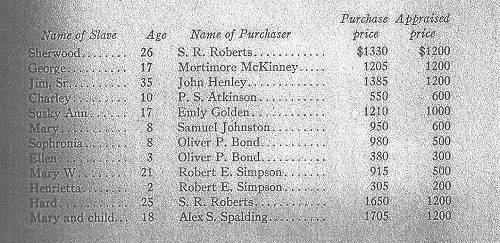
20 List at Slave Sale
Click image for larger viewMorris, a negro about twenty seven years old, was to be sold at the courthouse in Waynesville on February 5, 1844, to pay the debts of a deceased slaveholder. Many other slave sales under execution could be mentioned. While in probate the slaves of the estate were hired to the highest bidder. This was an important source of income to widows and minors
Although most of the slaves were treated humanely, there were some masters who were cruel and inhuman in dealing with their slaves. One master in a fit of anger lacerated the body of his slave with a crosscut saw. Another man was indicted by a grand fury for torturing, beating, wounding, and abusing a slave named Hannah, then in his employment and under his control. When the case was tried the accused person was discharged of the crime.
The following are examples of slaves who were given their freedom. By his last will and testament Jesse Evans of Osage County in 1843 freed three of his twenty slaves. The three manumitted slaves were Peter, Charity, a mulatto woman, and Elisabeth. In addition to his freedom Peter was to receive three horses, three head of cattle, fifteen head of hogs, a rifle gun, a house, bed and bedding, and house and kitchen furniture. Charity was to receive one mare, two cows, thirty head of hogs, a house, bed and bedding and house and kitchen furniture. During the remainder of their natural lives, these three freed slaves were to be given use and benefit in common of forty acres of land. The other seventeen slaves of Jesse Evans were partitioned among his heirs. The will of Jonathan Halloway, recorded in the Probate Court of Benton County on December 25, 1840, provided that all of his negroes were to be freed at the age of fifty five and all their children at the same age on condition that “they, or any of them, are of good character and able to maintain themselves.” The tenth article of the last will and testament of Jesse Kendrick, recorded in the Probate Court of Miller County on October 7, 1839, declared, “I give and bequeath unto Reuben my slave his freedom, from and after my death with his gun and all his property.” In Jefferson City, a negro washerwoman, who had become free, worked for money to buy her husband. After she had been successful in this, she and her husband worked to buy “Cudge,” their son, in which they were also successful.
A runaway slave, like a stray horse, was advertised. When seized and placed in custody of the law, he was reclaimed by the owner upon payment for service rendered and expenses incurred. If the owner did not appear within a certain time, the county court made an order for the sale of the slave, which was executed by the sheriff. Alfred, a mulatto slave, belonging to John Berry, who lied in Cole County, eighteen miles south of Jefferson City, ran away. The owner offered a reward of five dollars if he should be taken in Jefferson City, ten dollars if taken anywhere else in the county, twenty five dollars if taken in an adjoining county, fifty dollars if taken anywhere else in the state, and seventy five dollars if taken out of the state. “The taker up” was to confine him in any safe place and notify the owner by letter direct to Moreau Post Office. Negro twins owned by John Shipley, who lived in Osage County, eight miles from the mouth of the Osage River, ran away on September 10, 1847. The owner offered one hundred dollars reward for delivering both slaves, or fifty dollars for either. Two negro men ran away from James Bowden in Morgan County on August 2, 1848. A reward of fifty dollars was offered to the person who would deliver the runaways or secure them in jail so that the owner could get them. On March 23, 1838, Warren Dixon, who resided six miles south of Jefferson City missed a negro girl about four years old. The girl was described as having a “yellow complexion, very likely, and uncommonly smart.” It was thought highly probable that she had been kidnapped. A runaway slave, who called himself William Harris, was committed to Cole County jail on October 21, 1835. This runaway was described as a mulatto twenty four years of age with a “large scar over the left eye, and one on the left jaw, and is about five feet six inches high, speaks French.” A runaway slave was committed to the jail of Morgan County on September 11, 1854. If not claimed by the owner, he was “to be sold at public auction, before the Court House door in the town of Versailles.” A slave in Miller County, who had a wife in Jefferson City, ran away in 1840. The owner, David P. Taylor, offered rewards ranging from ten to a hundred dollars. There were many other instances of fugitive slaves, but in a work of this kind it would hardly be profitable to mention all of them.
Slave traders visited Jefferson City. In the fall of 1845 W. Edgerton was staying at the National Hotel for a few weeks to buy “a few negro slaves.” Young slaves were wanted. In 1850 John M. Maize, who was to be found at the Paulsell House at Jefferson City, bought negroes for Blake McAfee, 93 Olive Street, St. Louis. The buyer offered to pay the highest cash price for negroes of every description. December 11, 1858, the California News at California reported that “forty negroes passed down in the cars on Wednesday last, destined, we suppose, for the South.” The Pacific Railroad at this time extended as far west as Tipton.
Slaves were given jury trials, and in case of conviction of a capital offense they were to receive the same punishment as the whites. In Crawford County a negro girl named Mary was hanged for murder. Upon the expectation of being sold by her master, she had drowned one of his children. After a number of legal delays the execution took place at Steelville on August 11, 1838.
Free Negroes
Free negroes or mulattoes were not allowed to reside in any county without a license. When a free negro or mulatto applied for a license, he or she was required to enter into a bond to the state with one or more securities. For example, on May 9, 1853, Bill Whitenberg, a free negro, presented to the County Court of Crawford County his bond for “his good behavior as such negroe.” In 1860 Nancy Ann Maupin, a free colored person who did housework filed with the County Court of Moniteau County her bond for her good conduct and behavior, in the sum of $500, with T.M. Rice and William Stewart as securities. The county Court of Cole County on May 7, 1832, granted leave to Cato, a free man of color, to obtain a license to keep a public ferry across the Missouri River at Marion. A ferry and grocery license was then granted to this negro.
I doubt if very many people today know the extent to which the slave trade was prevalent in our area of the middle of the country. However, if you have read some of the steamboat stories we have on the website you may remember that often references are made to the black workers on those boats at the time even long after the Civil War.
Last April 29 I presented the story of Robert Oligschlaeger, St. Elizabeth native, who had donated to our museum a handmade wooden replica of his home and barn for which he had devoted seventeen years to build. You can read the full story of Robert and his family on the previous Progress Notes of April 19, 2010.
Sadly, we learned last week that Robert had passed away. His burial and a memorial service occurred at the St. Lawrence cemetery in St. Elizabeth last Saturday, July 17. Copied below is his obituary:
Jefferson City News Tribune
July 13, 2010
Robert Urban "Bob" Oligschlaeger (photo 21).
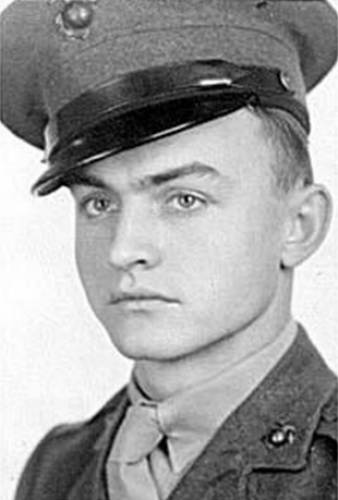
21 Bob Oligschlaeger Robert Urban "Bob" Oligschlaeger, 87, of Aplington, Iowa, died Friday, July 9, at Maple Manor Nursing Home in Aplington, Fortified with the sacraments of the Holy Mother Church.
Bob was born March 3, 1923, at St. Elizabeth, Missouri, the son of Bernard and Alma (Schell) Oligschlaeger. Robert Urban Oligschlaeger married his high school sweetheart, Freda Rose Crane, of Tuscumbia, Missouri and they became the parents of eight children. After Freda's death in 1980, Bob married Marjorie DeBower Schuck of Aplington, Iowa, in 1983.
Bob Oligschlaeger was a 1940, graduate of Tuscumbia, High School and was particularly proud of being a starting player on the school's basketball team that won the 1940 Eldon Tournament. In 1942, Bob enlisted in the U.S. Marine Corps, and served as a radioman and gunner on a twin engine PBJ-1 bomber in WWII. He served in the Pacific Theater of the war, achieving the rank of Tech Sergeant and earning the U.S. Armed Forces Air Medal for meritorious service in combat over Rabaul and Kavieng. After WWII, Bob worked as a radio and TV repairman in Jefferson City for several years. He then owned and operated several agricultural services firms, including St. Elizabeth Farm Supply Company, Lawson-Robinett Farm Supply, Anchor Milling Company and Empire Foods of Springfield, Missouri. The former became one of the largest turkey producers in Missouri. For a period of time, Bob served as President of the Missouri Turkey Federation. In 1983, Bob and Marjorie retired to Tuscumbia and resided there for several years with their beloved dog, "Boots." They moved to Aplington in 1995, and lived happily there until the present. Bob enjoyed woodworking and produced hundreds of carefully crafted heirlooms for family and friends.
Celebrating the memory of Robert Urban Oligschlaeger include his wife, Marjorie, of the home, and six daughters: Judy Meyer (Kevin) of Osage Beach, Mo.; Mary Wright (Alan) of St. Louis, Mo.; Martha Oligschlaeger of Osage Beach, Mo.; Susan Reynaga of San Diego, Calif.; Helen Allen (Fred) of Springfield, Mo.; Christine Vallely (David) of Springfield, Mo.; and one son: Robert Oligschlaeger, of St. Elizabeth, Mo. Robert's life was graced with 17 grandchildren and 16 great-grandchildren. Also surviving are four step-children: Gaylen Schuck (Linda) of Arkadelphia, Ark.; Diane Meester (Norm) of Springfield, Mo.; Russ Schuck (Gail); and Becky Jungling (Hank), of Aplington, Iowa. In addition, there are 10 step-grandchildren; 29 great-grandchildren, and two great-great-grandchildren. Surviving sisters are: Helen Hirsch (Don) and Jeanette Branch (Jack) of Jefferson City, Mo.
Deceased brothers and sisters are: Leroy Oligschlaeger (Gerry) and Blanche Kemna (Emil) of Jefferson City, Gerald Oligschlaeger (Ann) of St. Louis and Delores Ritter (Kraft) of Port Clinton, Ohio. Robert Urban Oligschlaeger was preceded in death by his first wife, Freda Rose Crane, and their infant son, James.
Services were held Monday, July 12, 10:00 a.m., at Bethel Reformed Church in Aplington, Iowa and will also be Friday, July 16, 10:00 a.m. at St. Roch Catholic Church in St. Louis, Mo. Burial will be Saturday, July 17, at 11:00 a.m., in the St. Lawrence cemetery at St. Elizabeth Missouri.
Judy and I attended the burial ceremony at St. Elizabeth. A large crowd of relatives and friends were present (photo 21a).
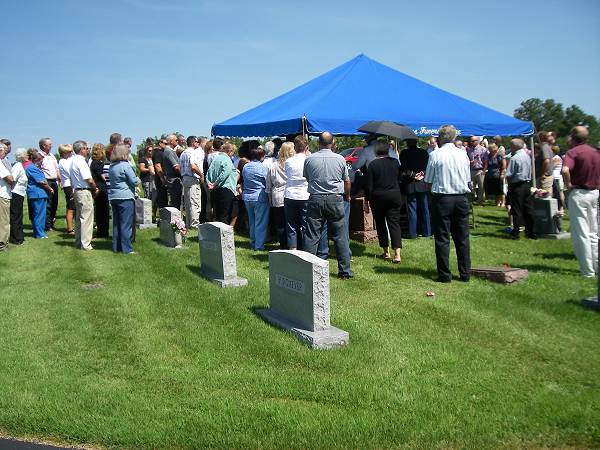
21a Burial Site at St. Lawrence Cemetery Bob was a decorated veteran of the Marine Corps having served in WWII so an honor guard was present for the burial (photo 21b).
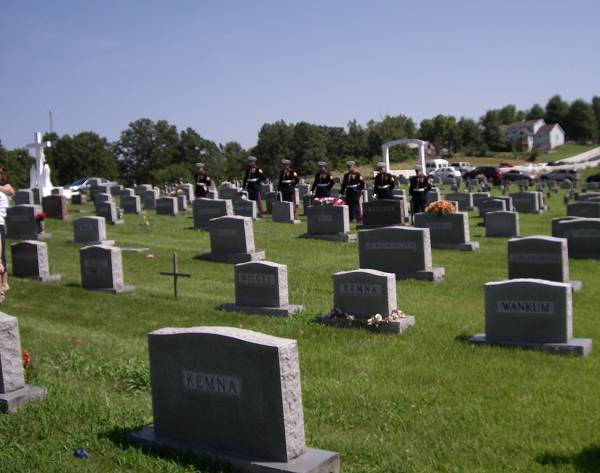
21b Honor Guard Afterward a dinner was served in the Community Center where a display of some of Bob’s mementos related to his service in WWII was presented (photo 21c).
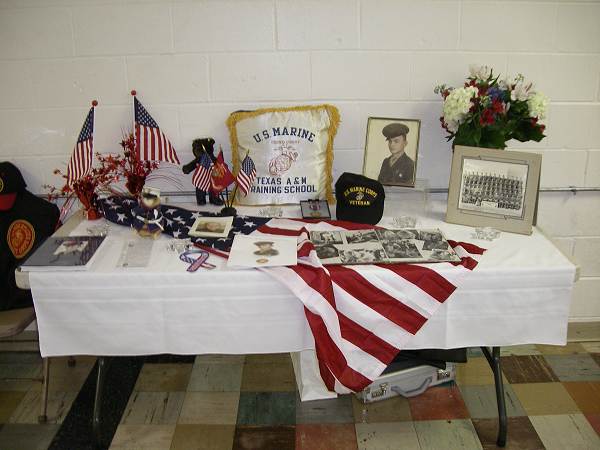
21c WWII Awards and Memorabilia
A couple of Saturdays ago, July 10, we enjoyed a very well attended ice cream social event. More guests came this year than ever before. For many it was their first visit to our museum; I was very pleased to receive many favorable comments about the museum’s design and displays, for which our great volunteer staff headed up by director Nancy Thompson, can take credit. Here is a photo published this week in the Advertiser of a number of guests who were enjoying the music of Joe Jeffries and his group (photo 22).
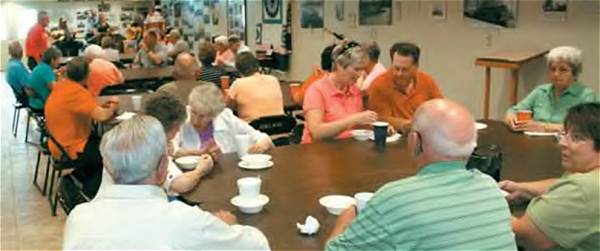
A large number of people attended the annual ice cream social at the
Miller County Historical Society Museum in Tuscumbia Saturday, July 10.
(Photo by Ginny Duffield)
That’s all for this week.
 Joe Pryor
Previous article links are in a dropdown menu at the top of all of the pages.
|

